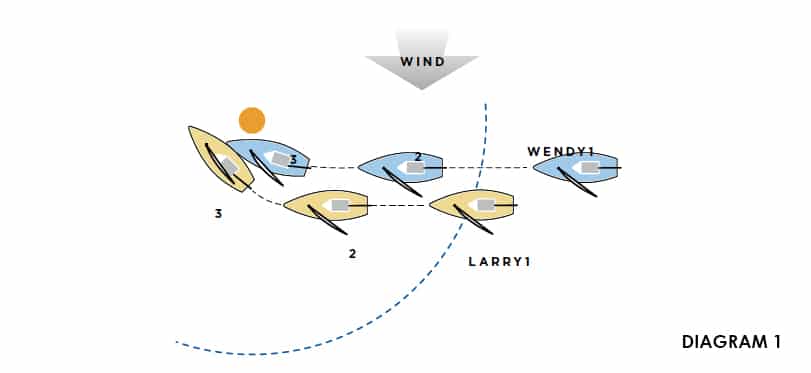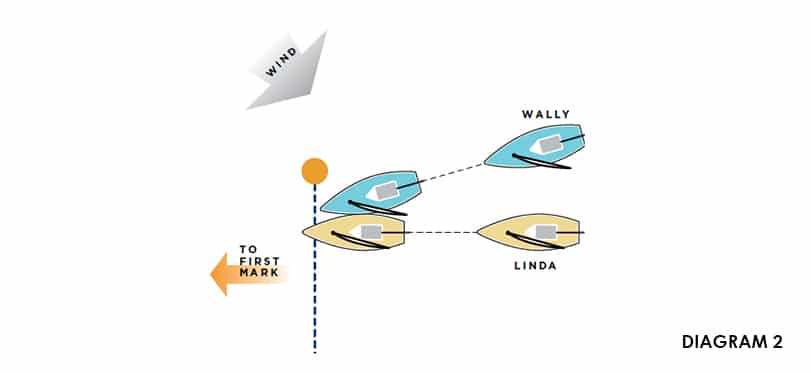

Rule 14, Avoiding Contact, first appeared in 1997, the year the entire rulebook was rewritten to provide an improved, simpler and better organized set of rules. Before the rewriting project began, many competitors were consulted and asked what changes they wanted. Many requested rules that put increased emphasis on avoiding damage. Their requests led to the elimination of the right of a leeward boat to luff as fast and as hard as she pleased, even if her luff resulted in damage to the windward boat. It also led to the introduction of Rule 14, which applies to all boats at all times, whether they’re the right-of-way boat or the keep clear boat, and whether they are entitled to room or required to give it.
Rule 14, Avoiding Contact
A boat shall avoid contact with another boat if reasonably possible. However, a right-of-way boat or one entitled to room or mark-room (a) need not act to avoid contact until it is clear that the other boat is not keeping clear or giving room or mark-room, and (b) shall be exonerated if she breaks this rule and the contact does not cause damage or injury.
The rule’s intended message is, put simply: “Sailing is not a contact sport.”
In the years 1993 to 1996, several versions of Rule 14 rules were tested in fleets all over the world. The first test version of Rule 14 contained only the first sentence of the current rule. That was too simple, and led to a problem and complaints. The problem was this: Before the start, when boats are reaching back and forth below the line, a game of “chicken” often broke out between boats on opposite tacks. Both boats would bear off at about the same time to avoid contact, then both headed up, then both bore off, etc. Instead of reducing collisions, that one-sentence rule seemed to increase them. To solve the problem Rule 14(a) was added. It permits the right-of-way boat to hold her course until it becomes clear the other boat is not keeping clear. The complaints came because right-of-way boats and boats entitled to room were being disqualified for breaking Rule 14 when the contact was very minor and hadn’t caused damage. To quell the complaints, Rule 14(b) was added.
Today’s Rule 14 has several unique features that set it apart from all other rules in Part 2, Rules When Boat Meet.
Rule 14 is the only rule with its own special exoneration provision. Under Rule 14(b), whenever you have right of way or are entitled to room for some maneuver, you will be exonerated for breaking Rule 14 if the contact does not cause damage or injury. But don’t take this as a license to start colliding with other boats. A boat is considered “damaged” if its value or usefulness is at all reduced (see ISAF Case 19), so even a scratch may be considered damage.
Rule 14 has another feature that somewhat reduces its impact. There’s no double jeopardy in sailing—if you break two or more rules in a single incident, you are only penalized once. For example, suppose Bill is required by Rule 10 to keep clear of Alice, but instead he collides with Alice when it was possible for him to have avoided her. Bill breaks both Rule 10 and Rule 14, but he is required to take only one Two-Turns Penalty (see Rule 44.1) and, if he is protested, his penalty, a DSQ, is not increased because he broke two rules. So whenever you break both Rule 14 and another rule, the fact that you broke Rule 14 does not really hurt you.
You may be beginning to think that Rule 14 is not particularly important. That’s simply wrong. Rule 14 becomes very important just when you think you’re in the catbird seat, as the following two examples show.
Larry and Wendy are approaching a mark at the end of a reach and will be rounding it to starboard onto a beat. As the first diagram shows, Larry is clear ahead of Wendy at the zone. At Position 1, Larry has right of way over Wendy (Rule 12), is entitled to mark-room from Wendy (Rule 18.2(b), second sentence), and while he is sailing within that mark-room he can change course as rapidly as he likes and will be exonerated if he breaks Rule 16.1 (Rule 21(a)). What’s more, Wendy is required by Rule 14 to avoid contact with Larry.
Later, at Position 2, when Wendy establishes an inside overlap, Larry retains right of way (Rule 11) and Wendy must continue to give him mark-room (Rule 18.2(c)(1)). Larry’s advantage under the rules gets even stronger because Wendy must now also give him room to sail his proper course (Rule 18.2(c)(2)). Wendy could avoid breaking five rules by luffing up and passing the mark on the wrong side. But she doesn’t. As she nears the mark, it becomes clear that she will not keep clear of Larry, give him mark-room, or give him room to sail his proper course. At that moment, Rule 14 begins to apply to Larry (see Rule 14(a)). It requires him to act to avoid contact with Wendy if is reasonably possible to do so. It would be easy to do so—all he needs to do is hold the course he has been sailing since Position 1. If he does, there will be no contact. Instead, a bit overconfident because so many rules give him rights, Larry luffs rapidly close in front of Wendy and they collide, causing damage to both boats. Larry protests Wendy. The protest committee throws the book at Wendy. She is disqualified for breaking Rules 11, 14, 18.2(b), 18.2(c)(1), and 18.2(c)(2). The committee decides Larry’s luff was so rapid that he didn’t give Wendy room to keep clear, and in doing so, he broke Rule 16.1. Not to worry, he’s exonerated for that breach under Rule 21(a), but no rule exonerates Larry for breaking Rule 14, so in the end, he’s disqualified, too. Wendy broke five rules and Larry broke just one, but both boats end up with a DSQ. Under U.S. law, both boats were at fault, and each will likely be responsible for 50 percent of the cost of repairs to the boats (see US Prescription 67(c)).
The second diagram looks similar to the first, but the incident occurs at a start. The first leg of the course is a beam reach. Linda and Wally are converging as they approach the line to start. Neither changes course and they collide with damage to both boats. Linda protests Wally. At Position 1, Wally must keep clear of Linda (Rule 11) and he also must avoid contact (Rule 14). Because the starting mark is surrounded by navigable water, Rule 18 doesn’t apply (see the Preamble to Section C of Part 2). Wally is barging and Linda is under no obligation to give him mark-room. Wally could avoid breaking any rule by luffing and leaving the mark to port. But he doesn’t, and just before Position 2, Wally commits to sailing between Linda and the mark. At that moment, it becomes clear that Linda needs to take avoiding action in order not to collide with Wally, so Wally is not keeping clear (see part (a) of the definition Keep Clear). At the same moment Rule 14(a) begins to require Linda to act to avoid contact, which she easily could do by bearing off a few degrees.
The protest committee disqualifies both boats—Wally for breaking Rules 11 and 14 and Linda for breaking Rule 14. Again, both boats were at fault, and each will likely be responsible for 50 percent of repair costs. The lesson here is clear: Pay particular attention to Rule 14 when the rules have put you in an advantageous position. Rule 14 never sleeps.
The two incidents described above and the diagrams are based on appeals decided in the United Kingdom by the Royal Yachting Association. They appear in the RYA Case Book, which can be found at www.rya.org.uk/go/RRSguidance. I am grateful to the Royal Yachting Association for its permission to use this material.
E-mail for Dick Rose may be sent to rules@sailingworld.com.









